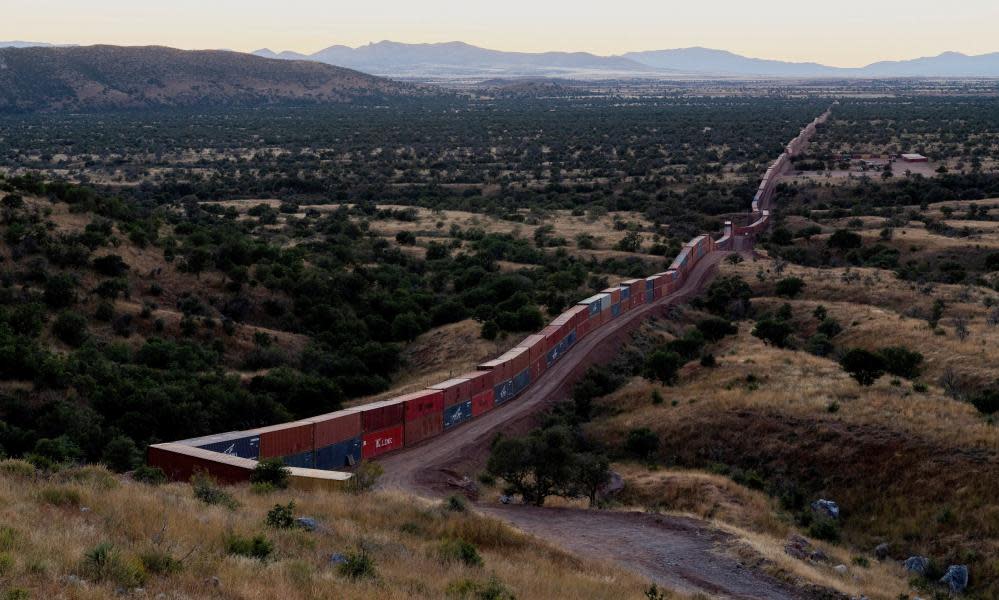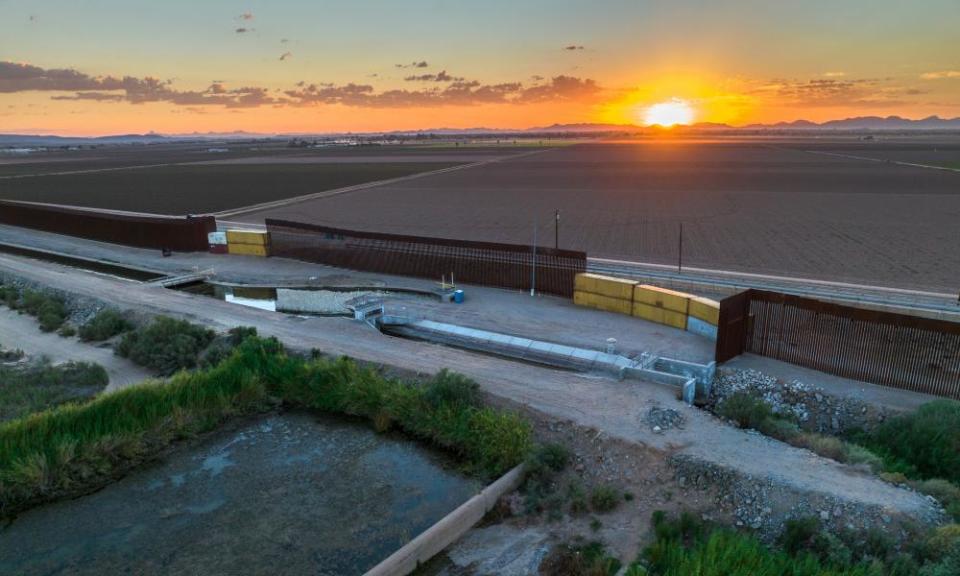Arizona governor builds border wall of shipping crates in final days of office

- Oops!Something went wrong.Please try again later.
- Oops!Something went wrong.Please try again later.
A makeshift new barrier built with shipping containers is being illegally erected along part of the US-Mexico border by Arizona’s Republican governor – before he has to hand over the keys of his office to his Democratic successor in January.
Doug Ducey is driving a project that is placing double-stacked old shipping containers through several miles of national forest, attempting to fill gaps in Donald Trump’s intermittent border fencing.
The rusting hulks, topped with razor wire and with bits of metal jammed into gaps, stretch for more than three miles through Coronado national forest land, south of Tucson, and the governor has announced plans to extend that up to 10 miles, at a cost of $95m (£78m).
Ducey's shipping container wall on the AZ-MX border is worse than I imagined. I went down yesterday to see it myself for a Border Chronicle story. Imagine 10 miles of this through a national wildlife forest. This is happening right now👇👇 pic.twitter.com/mqCjVo59iA
— Melissa del Bosque (@MelissaLaLinea) November 30, 2022
The area, with mountain ranges rising abruptly from the desert and a diverse environment of plants and animals, is federal land maintained by the US Forest Service.
Ducey had first experimented with a smattering of shipping containers in August in Yuma, in the south-west corner of the state, bordering California and Mexico, aiming to stop migrants and asylum seekers.
Since Donald Trump implemented the Title 42 rule in 2020 when he was president, which closed ports of entry to most seeking asylum in the US, people have sought gaps in barriers elsewhere in order to request asylum from border agents. The rule appears still to be on track to end later this month although a long legal battle is taking place.
Ducey issued an executive order in August to erect old shipping containers near Yuma, and 11 days later workers had installed 130 of what he described as “22ft-high, double stacked, state-owned, 8,800lb, 9x40ft containers, linked together and welded shut”.
In October, Ducey filed a lawsuit in which he claimed that the federal land along the border known as the Roosevelt Reservation actually belongs to the state, not the US government, and that Arizona has the constitutional right to protect itself against what he termed an invasion, citing “countless migrants” resulting in “a mix of drug, crime and humanitarian issues”.
US attorneys issued a withering response, refuting the claims.
The US Bureau of Reclamation and the Cocopah tribal nation said that Ducey was violating federal law by placing the containers on federal and tribal land there. In a letter, the bureau demanded that the state remove the containers. But the state has not, and has since been emboldened to embark on the larger project now proceeding apace more than 300 miles to the east.

The Cochise county sheriff, Mark Dannels, supports the new series of shipping containers being placed in his county, hoping “it will deter crime and stop criminal behavior”.
But as the line of metal boxes snakes west towards adjacent Santa Cruz county, the sheriff there, David Hathaway, told the Nogales International newspaper that if anyone tries to put the containers in his jurisdiction they will be arrested for illegal dumping.
Dinah Bear, an attorney and former general counsel for the council on environmental quality within the executive office of the White House said Ducey’s lawsuit was “shockingly bad” and “frivolous”.
“There’s just no question that this is federal property,” she added, as well as being public land, meaning “there’s no legal difference between the land they’re putting the shipping containers on and Grand Canyon national park.”
To block the project, she said US Forest Service agents “would definitely want a court order from a judge … They’re not going to go down to the border and have a shootout with state police or arrest the governor at the [state] capitol.”
Federal judge David Campbell, based in Phoenix, is presiding over the case, but no hearing has been called yet.
“The clock is ticking,” Bear said, with courts backed up and the holidays approaching.
The incoming Arizona governor, Democrat Katie Hobbs, who will assume office on 2 January after beating Republican candidate Kari Lake in the midterm elections, has said she will remove the containers.
Bear predicts Campbell will order the removal.
But before that happens, they are being laid down by a contractor called AshBritt, a Florida-based disaster remediation firm. A local media investigation found that Ducey’s announced $6m cost for the Yuma barriers had actually cost $13m.
Daily protests by locals alarmed at the project have slowed what was breakneck-speed installation, but not managed to halt it.
Meanwhile, Mark Ruggiero, the former Sierra Vista district ranger for the US Forest Service in Cochise county, said the shipping containers are a hazard that jeopardize a binational firefighting agreement with Mexico.
“I was shocked to see this barrier going in,” he said. “It’s an illegal action on public land.”
As a barrier for humans, the double-stacked boxes are not much of an obstacle, but they are an existential threat to endangered migratory species, especially jaguars and ocelots, as well as being an eyesore.
Emily Burns, program director for Sky Island Alliance, a binational conservation nonprofit that tracks wildlife in the Coronado national forest said: “There was no environmental review or planning or mitigation that was done.”
The Center for Biological Diversity was allowed to join the federal government as a defendant in Ducey’s lawsuit and has slammed the barrier as damaging and a political stunt.
Meanwhile, Burns noted that her organization has 70 wildlife cameras in this stretch of border and they rarely see migrants crossing there.

